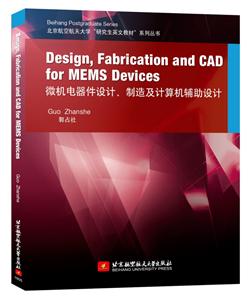微机电器件设计.制造及计算机辅助设计
内容简介
[
Thisbookfirstlyintroducesthepertinentfundamentaltheory,importantmaterialandfabricationprocessofmicroGelectromechanicalsystems.Basedonthesetheories,thedesignruleandimportantengineeringexamplesaredescribedindetail.Then,manyengineeringapplicationsforMEMSincludingtheaccelerationmeasurement,theangularspeedmeasurementandthepressuremeasurementareintroduced.Finally,finiteelementmethodisintroducedinordertoprovethecorrectnessofthedesign.Thisengineeringapplicationofsimulationincludesthestaticandmodalanalysisofthebeam,capacitanceanalysis,thermalGstructureanalysisofthedeviceandfatigueanalysisetc.Itcanbeselectedasthereferencetothepostgraduates,undergraduatesandpertinentengineeringstaffwhoseresearch directionsareinstrumentationscienceandtechnology,controlscienceandengineering,mechanicalengineeringetc.
]
目录
Chapter1 Introduction ………………………………………………………………………… 11.1 ConceptofMEMS ……………………………………………………………………… 11.2 DevelopmentofMEMS ………………………………………………………………… 41.3 MEMSCAD …………………………………………………………………………… 9Chapter2 BasictheoryofMEMS …………………………………………………………… 122.1 TheoryofelectrostaticMEMScombactuators …………………………………… 122.1.1 Introduction ……………………………………………………………………… 122.1.2 Operatingprinciples …………………………………………………………… 132.1.3 Platecapacitortheoryinidealcondition ……………………………………… 142.1.4 ThemodifiedmodelofMEMSplatecapaciator ……………………………… 172.1.5 Calculationofelectrostaticcombdrivingforceinidealsituation …………… 242.1.6 Weakcapacitancedetectionmethodofelectrostaticcombdrive …………… 262.2 RelevanttheoreticalcalculationsfortheMEMScantileverbeam ………………… 342.2.1 Introduction ……………………………………………………………………… 342.2.2 Theoreticalcalculationmethodforcantileverbeam ………………………… 352.2.3 RelevanttheoreticalcalculationofaxialtensileandcompressiveonsingleGendclampedbeams ………………………………………………………………… 362.2.4 RelatedtheoreticalcalculationsofdoubleGendclampedbeamsaxialtensionandcompression ………………………………………………………………… 402.3 MembranetheoryofMEMS ………………………………………………………… 472.3.1 Theoryofclampedaroundcirculardiaphragm ………………………………… 482.3.2 Theoryofclampedaroundrectangularflatdiaphragm ……………………… 49References …………………………………………………………………………………… 52Chapter3 MEMSmaterials …………………………………………………………………… 533.1 Monocrystallinesilicon ……………………………………………………………… 533.1.1 Introduction ……………………………………………………………………… 533.1.2 Crystalorientationofmonocrystallinesilicon ………………………………… 553.2 Polycrystallinesilicon ………………………………………………………………… 643.3 Silica …………………………………………………………………………………… 663.4 Piezoelectricmaterials ………………………………………………………………… 673.4.1 Piezoelectriceffectandinversepiezoelectriceffectofmaterials …………… 673.4.2 Quartzcrystal …………………………………………………………………… 683.4.3 Piezoelectricceramics …………………………………………………………… 733.5 OtherMEMSmaterials ……………………………………………………………… 753.6 Summary ……………………………………………………………………………… 76Chapter4 MEMStechnology ………………………………………………………………… 774.1 MEMSlithographyprocess ………………………………………………………… 784.2 KeytechnologyofMEMSlithographyprocess …………………………………… 804.2.1 Wafercleaning …………………………………………………………………… 804.2.2 Siliconoxidation ………………………………………………………………… 804.2.3 Spincoatingprocess …………………………………………………………… 874.2.4 Prebaking ………………………………………………………………………… 904.2.5 Exposure ………………………………………………………………………… 924.2.6 Development ……………………………………………………………………… 944.2.7 Hardening ………………………………………………………………………… 964.2.8 FabricationoftheSiO2 window ………………………………………………… 974.3 SubsequentprocessofMEMS ……………………………………………………… 984.3.1 Bulksilicontechnology ………………………………………………………… 984.3.2 Surfacesiliconprocess ………………………………………………………… 1034.3.3 LIGAtechnology ……………………………………………………………… 1044.3.4 Sputteringtechnology ………………………………………………………… 1054.3.5 LiftGoffprocess ………………………………………………………………… 1074.4 Filmpreparationtechnology………………………………………………………… 1074.5 Bondingprocess ……………………………………………………………………… 1084.5.1 Anodicbondingprocess………………………………………………………… 1094.5.2 SiliconGsilicondirectbonding ………………………………………………… 1104.5.3 Metaleutecticbonding ………………………………………………………… 1134.5.4 Coldpressureweldingbonding ……………………………………………… 1144.6 EngineeringexamplesofcombinationformultipleprocessestofabricatetheMEMSdevice ………………………………………………………………………… 1154.6.1 Introduction …………………………………………………………………… 1154.6.2 EngineeringexampleoffabricationprocessforresonantMEMSgyroscope…………………………………………………………………………………… 1154.6.3 EngineeringexampleofelectromagneticmicroGmotorproductionprocess…………………………………………………………………………………… 1184.7 Summary ……………………………………………………………………………… 124References…………………………………………………………………………………… 125Chapter5 Frictionwearandtearundermicroscale ……………………………………… 1265.1 OffGchiptestingmethodformicrofriction ………………………………………… 1275.1.1 MicroGtribologytestwiththepinGonGdiscmeasuringmethod ……………… 1275.1.2 MicroGtribologytestwithAFM ……………………………………………… 1285.1.3 MicroGtribologytestwithspecialmeasuringdevice ………………………… 1305.2 OnGchiptestingmethodformicrofriction ………………………………………… 1325.2.1 OnGchiptestingmethodactuatedbyelectrostaticforce …………………… 1325.2.2 OnGchipmicroGfrictiontestingmethodusingthemechanismcharactersofthebimorphmaterial…………………………………………………………… 1395.3 ExampleofthedesignforanonGchipmicroGfrictionstructure ………………… 1415.3.1 Structureandworkingprinciple ……………………………………………… 1415.3.2 Calculationofpertinenttheory ……………………………………………… 1425.3.3 Technologicalanalysisofstructuraldesign ………………………………… 1485.3.4 Testingresultsanddataanalysis……………………………………………… 1525.3.5 ResearchandtestofwearproblemofMEMSdevices ……………………… 1615.4 Summary ……………………………………………………………………………… 165References…………………………………………………………………………………… 165Chapter6 MEMStestingtechnologyandengineeringapplication ………………………… 1696.1 Accelerationmeasurementandcorrespondingsensors …………………………… 1696.1.1 Workingprincipleoftheaccelerationsensorandtheclassification ……… 1706.1.2 Capacitivesiliconmicromechanicalaccelerometer …………………………… 1726.1.3 Piezoresistivesiliconmicromechanicalaccelerometer ……………………… 1736.1.4 Piezoelectricmicromechanicalaccelerometer ………………………………… 1746.1.5 ResonantsiliconMEMSaccelerometer ……………………………………… 1756.2 Angularspeedmeasurementandcorrespondingsensors ………………………… 1776.2.1 Workingprinciple ……………………………………………………………… 1776.2.2 DevelopmentofMEMSgyroscope …………………………………………… 1786.2.3 Classificationofmicromechanicalgyroscope ………………………………… 1886.3 Pressuremeasurementandcorrespondingsensors ……………………………… 1906.3.1 Workingpincinple ……………………………………………………………… 1906.3.2 Resonantsiliconmicromechanicalpressuresensoranditsdevelopment … 1936.4 MeasurementofmicroGtorque ……………………………………………………… 1986.4.1 Introduction …………………………………………………………………… 1986.4.2 Workingprincipleofnoncontactmethod …………………………………… 1996.4.3 Theoreticalcalculation ………………………………………………………… 2006.4.4 Correspondingequipmenttorealizethenoncontactmethod ……………… 2056.4.5 Experimentresultanddiscussion …………………………………………… 2096.5 Microscopicmorphologytestingmethod ………………………………………… 2116.6 Summary ……………………………………………………………………………… 212References…………………………………………………………………………………… 212Chapter7 ApplicationexamplesofthefiniteelementmethodinthedesignofMEMSdevices …………………………………………………………………… 2187.1 Importantconceptsofthesoftware………………………………………………… 2187.2 IntroductionoftheAnsyssoftwareinterface……………………………………… 2207.3 ThecoordinatesysteminAnsys …………………………………………………… 2217.4 Engineeringexamples ……………………………………………………………… 2267.4.1 StaticanalysisofsingleGclampedbeam ……………………………………… 2267.4.2 ModalanalysisofdoubleGclampedbeam ……………………………………… 2457.4.3 CapacitanceanalysisofMEMSelectrostaticcombfingersdrive …………… 2577.4.4 Fatiguestrengthcalculationexample ………………………………………… 2647.5 Summary ……………………………………………………………………………… 272
封面

书名:微机电器件设计.制造及计算机辅助设计
作者:郭占社
页数:未知
定价:¥65.0
出版社:北京航空航天大学出版社
出版日期:2016-05-01
ISBN:9787512421097
PDF电子书大小:156MB 高清扫描完整版
